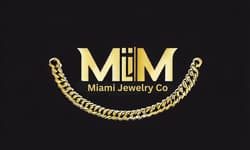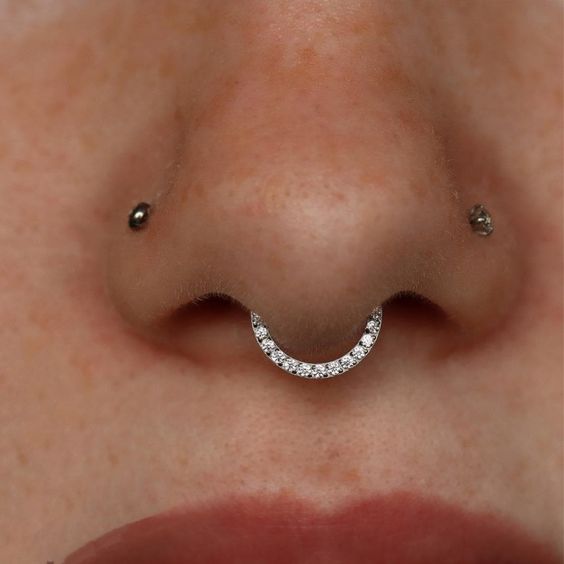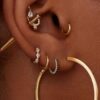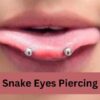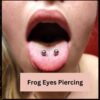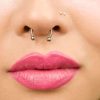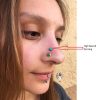Nose Piercing
Septum Piercing Placement: The Ultimate Guide for the Perfect Sweet Spot
You’ve just got a septum piercing, only to find the placement seems off or even causes discomfort. It’s not merely a cosmetic concern; it’s a matter of your piercing’s health and longevity. Nailing that perfect ‘sweet spot’ for the piercing can be tricky, but what if you had a foolproof guide to get it right?
To determine the ideal placement for a septum piercing, one should identify the ‘sweet spot’ – a softer region in the septum. Gently squeeze the bottom of your septum, the area between both nostrils. Amidst the firmer cartilage, you’ll discover a thin, more pliable section of skin. This is the precise location for optimal septum piercing
In this guide, we’ll explore:
- The elusive ‘sweet spot’ and how to locate it.
- Visual examples of both correct and incorrect septum piercing placements.
- Essential tips on what to look out for and pitfalls to avoid.
- The irreplaceable value of relying on a seasoned professional.
- Consequences of a misplaced piercing and actionable steps for correction.
- The often-asked question: Does everyone even have a septum sweet spot?
- Aftercare best practices and selecting the ideal jewelry for your new piercing.
Plus, a plethora of FAQs to quench your every curiosity. Dive in and let’s demystify the art and science behind the perfect septum piercing placement.
Contents
- 1 Anatomy of the Septum
- 2 How To Find Your Sweet Spot – Video Guide
- 3 Why Placement Matters For Your Septum Piercing
- 4 The Perfect Sweet Spot – How to Find It
- 5 How to Pierce Your Septum – Video Guide
- 6 Examples of Correct Septum Piercing Placement and Incorrect Septum Piercing Placement
- 7 What to look for and what to avoid:
- 8 Relying on a Professional
- 9 What happens if you pierce your septum in the wrong spot?
- 10 Does everyone have a septum sweet spot?
- 11 Is my septum pierced too far back?
- 12 How do I know if I pierced my septum correctly?
- 13 What should I do if I doubt my septum piercing placement?
- 14 Can incorrect septum placement be corrected?
- 15 What is the risk of repeatedly re-piercing the septum?
- 16 Aftercare and Healing
- 17 What to Expect:
- 18 Choosing the Right Septum Jewelry
- 19 FAQs
- 20 Conclusion
Anatomy of the Septum
Before we dive into the “sweet spot,” let’s get familiar with the territory. The nasal septum is basically the thin wall between your nostrils. It’s made up of cartilage in the front and bone in the back. And guess what? When we talk about septum piercings, we’re not actually piercing through that cartilage or bone. Surprised?
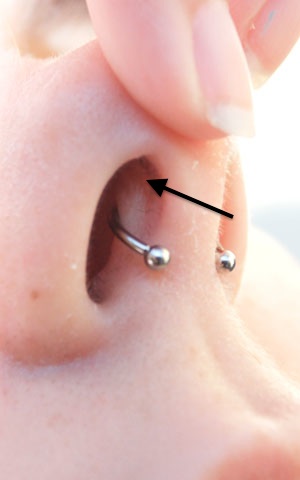

The ‘sweet spot’ explained:
This is where the magic happens. The “sweet spot” is a tiny, thin piece of soft skin and membrane located just in front of the cartilage. If you’ve ever felt the inside of your nose, you might’ve noticed a softer region between the tough cartilage and the tip of your nose. That, my friend, is where a skilled piercer will aim. It’s the least painful and the safest area to get pierced.
How To Find Your Sweet Spot – Video Guide
Why Placement Matters For Your Septum Piercing
Ensuring minimal pain during piercing:
You might have heard some horror stories about painful piercings, but here’s the truth: if done right, septum piercings can be one of the least painful types out there. But “if done right” is the keyword. A piercing through the sweet spot can be a breeze but miss that, and you might end up piercing through the cartilage. And trust me, you don’t want that.
Achieving the desired aesthetic:
I can’t stress this enough. Precision is key. A misplaced septum piercing can look crooked or off-centered. It’s like wearing a skewed tie or a lopsided hat – it just doesn’t sit right. For a piercing that’s front and center on your face, you’d want it to be perfect.
Avoiding complications and ensuring easy healing:
We all know how annoying a nagging injury can be. Similarly, a misplaced piercing can lead to extended healing times, infections, or even complications like septal hematoma. But get the placement right, follow proper aftercare, and you’ll be flaunting your new accessory with pride and without worries.
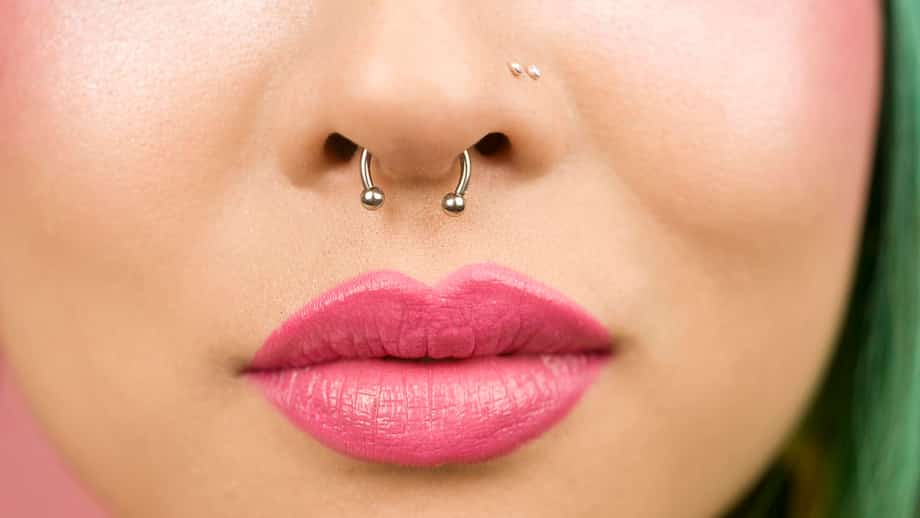
The Perfect Sweet Spot – How to Find It
Navigating the inner realms of our nose might not be a daily adventure for most of us, but when considering a septum piercing, it’s a journey worth taking. So, how do you find that elusive sweet spot?
Steps to Locate My Septum Piercing Sweet Spot:
- Wash Your Hands: First and foremost, cleanliness is crucial. Ensure you wash your hands thoroughly.
- Gentle Exploration: With your thumb and forefinger, gently pinch the tip of your nose. Slide your fingers upwards. As you move away from the tip, you’ll feel a harder, cartilaginous area. Keep going until you feel a softer, more pliable region. That’s your sweet spot!
- Compare: Press gently on both the cartilage and the soft spot. Notice the difference? The soft spot will give way with little resistance, unlike the harder cartilage.
How to Pierce Your Septum – Video Guide
Examples of Correct Septum Piercing Placement and Incorrect Septum Piercing Placement
The septum piercing has gained traction as a fashion-forward statement, and like any art form, its beauty lies in its precision. But how can you differentiate between a correctly placed piercing and an incorrect one?
Let’s break it down.
Correct Septum Piercing Placement
- The Sweet Spot: As mentioned earlier, the correct placement targets the thin strip of skin, the ‘sweet spot,’ and not the cartilage itself. The piercing should be symmetrical and centered.
- Comfort: A correctly placed septum piercing should be comfortable, causing minimal pain after the initial soreness subsides.
- Angle: The piercing should be perpendicular to the face, ensuring that the jewelry hangs straight down and doesn’t tilt to one side.
Visual Clues:
When looking straight into a mirror, the piercing should be in line with other facial features, like the nostrils or the lips, presenting a harmonious appearance.
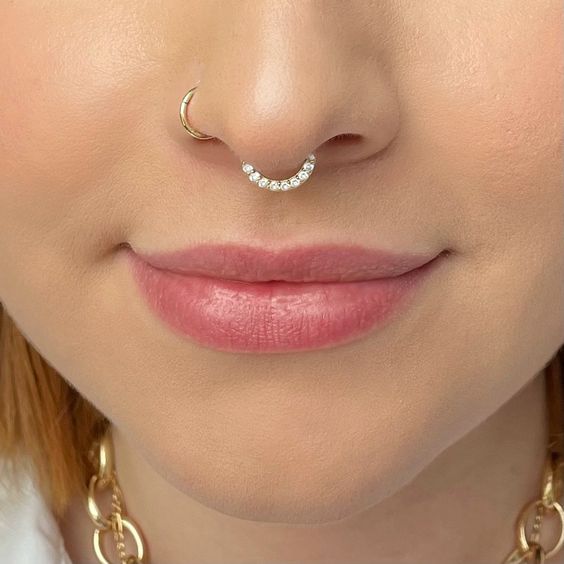
Incorrect Septum Piercing Placement
- Too Far Back: If the piercing is done too far back, it enters the thicker cartilage. This not only causes more pain but also prolongs the healing process.
- Asymmetrical: An off-center piercing can result in the jewelry hanging more towards one nostril, which might not give the desired aesthetic appeal.
- Angle Issues: If the piercing isn’t done perpendicular to the face, the jewelry might lean forward or backward or tilt to one side.
Visual Clues:
An incorrectly placed septum piercing might appear off-balance, and when the wearer hangs a straight piece of jewelry, it might not dangle in a perfect vertical line.
What If My Piercing Is Incorrectly Placed?
Mistakes happen, and if you suspect your septum piercing isn’t placed correctly, consult a professional. They can provide guidance on the next best steps, which might include removing the jewelry and allowing the piercing to heal before attempting a re-piercing.
What to look for and what to avoid:
Look for: A soft, thin stretch of skin that feels different from the tougher cartilage on either side. It might feel slightly “hollow” in comparison.
Avoid: Pushing or prodding too hard. The inner nose is sensitive. If you feel pain or discomfort, stop and reconsider trying again or consulting a professional.
Relying on a Professional
Why expertise is crucial:
While it’s fascinating to discover the sweet spot on your own, getting the piercing done is another ball game altogether. Just as you wouldn’t want an amateur to tattoo you, the same goes for piercings. A professional piercer has the experience, knows the nuances of the anatomy, and can ensure a clean, safe, and accurately placed piercing.
The tools and techniques they use:
- Piercing Needles: Professionals use specialized, single-use needles designed for precision and safety.
- Clamps: These help steady the septum and ensure the needle goes through the correct spot.
- Marker: A sterile marker might be used to mark the exact piercing point after assessing the septum.
- Gloves and Sterilized Environment: Ensuring cleanliness and avoiding any risk of infection.
What happens if you pierce your septum in the wrong spot?
Incorrect placement of a septum piercing can lead to several complications:
- Increased Pain: Piercing through thicker cartilage instead of the soft spot can be more painful.
- Prolonged Healing: The wrong spot may take longer to heal and be more prone to infections.
- Aesthetic Issues: The jewelry might not hang correctly or may appear asymmetrical.
- Potential for Scarring: Incorrect placements can result in unsightly scars if the piercing is eventually removed.
Does everyone have a septum sweet spot?
Most people do have a ‘sweet spot’—a thin, soft piece of skin devoid of cartilage. However, the size and exact location can vary. Some might have a larger or more pronounced sweet spot, while others might have a smaller one. It’s always advisable to consult with an experienced piercer who can feel and locate the spot accurately.
Is my septum pierced too far back?
Signs that your septum might be pierced too far back include:
- Increased Pain and Sensitivity: More discomfort than typical post-piercing pain.
- Jewelry Angling Backwards: The jewelry might lean back into the nose rather than hanging straight down.
- Difficulty in Changing Jewelry: It might be harder to switch out jewelry due to the awkward placement.
How do I know if I pierced my septum correctly?
A correctly pierced septum will:
- Align Centrally: It will be symmetrical and in line with other facial features.
- Cause Minimal Discomfort: Beyond the initial pain, it shouldn’t cause prolonged discomfort.
- Allow Jewelry to Hang Straight: No leaning forward, backward, or to the sides.
- Heal Relatively Quickly: With proper care, the initial healing should take 6-8 weeks.
- Learn more about Septum Ring Sizes
What should I do if I doubt my septum piercing placement?
If you have concerns:
- Consult a Professional: Get a second opinion from a reputable piercer.
- Avoid Playing with It: Minimize movement to prevent potential complications.
- Seek Medical Advice: If there are signs of infection or extreme discomfort, see a doctor.
Can incorrect septum placement be corrected?
Yes, but it typically involves:
- Removing the Current Piercing: Allow it to heal completely.
- Re-piercing: Once healed, seek a professional for correct placement.
What is the risk of repeatedly re-piercing the septum?
- Increased Scar Tissue: Multiple piercings can lead to a buildup of scar tissue.
- Potential for Deviated Septum: Repeated trauma may alter the septum’s alignment, though this is rare.
- Aesthetic Concerns: Multiple piercings can affect the way jewelry hangs or the overall look of the nose.
Aftercare and Healing
Embarking on your septum piercing journey doesn’t end the moment the needle goes through. The healing process and aftercare are where the real commitment begins.
What to Expect:
- Mild Pain and Discomfort: A slight throbbing sensation isn’t uncommon. It’s your body’s natural response to the procedure.
- Swelling: Just like any other piercing or small injury, expect a bit of swelling. This usually subsides within a few days.
- Tears: Not from pain, necessarily! The eyes might water due to the proximity of the piercing to the tear ducts.
- Cleanliness is Key: You’ll be advised to avoid touching the piercing and to clean it with a saline solution.
Long-Term Care
A piercing is not just a one-time commitment. It’s a long-term relationship between you and that little piece of jewelry on your body. And like any relationship, it requires care and attention.
Cleaning and maintaining your septum piercing:
- Saline Solution: Use a saline solution (a mix of salt and water) to clean the piercing. Dip a cotton ball into the solution and gently dab around the piercing. Avoid alcohol or peroxide as they can be too harsh and prolong the healing process.
- Avoid Twisting: While it may be tempting to play with your new piercing, avoid twisting or turning it, especially during the initial days.
- Stay Away from Pools: Chlorinated water can be harsh on fresh piercings. Ensure you avoid pools, hot tubs, and similar environments during the healing process.
Signs of infection and what to do:
- Redness and Swelling: While some redness and swelling are expected initially if they persist or worsen after a week, it’s a cause for concern.
- Pus: A clear or white discharge is normal. However, if it turns yellow or green, it may signal an infection.
- Excessive Pain: Some pain is expected, but if it’s unbearable or increases over time, seek advice.
- What to Do: If you suspect an infection, consult a professional. Avoid removing the jewelry as it can cause the hole to close, trapping the infection inside.
Choosing the Right Septum Jewelry
Factoring in the gauge size and material:
- Gauge Size: Typically, septum piercings are done with a 16-gauge needle. Ensure your jewelry matches this size, especially when changing it for the first time.
- Material: Opt for hypoallergenic materials like surgical steel, titanium, or gold. These reduce the risk of allergic reactions.
Trends and styles to consider:
- Hoop or Ring: A classic choice that never goes out of style.
- Septum Clicker: These have a hinge and come in various designs, from simple to ornate.
- Barbell: A unique choice for those looking for something different.
Adjusting and Replacing
When and how to change your septum ring:
Wait for the piercing to heal completely before attempting to change the jewelry. Ensure your hands are clean, and ideally, make the first change at a professional studio.
Ensuring the piercing remains healthy:
Regular cleaning, avoiding trauma to the area, and listening to your body are essential. If something feels off, consult a professional.
FAQs
Where is the correct location for a septum piercing?
The correct location for a septum piercing is the “sweet spot,” a thin, flexible section of skin located amidst the firmer septum cartilage. This can be identified by gently pinching the area between your nostrils.
Is my septum pierced in the wrong spot?
If your septum piercing isn’t in the “sweet spot” and instead feels like it’s through the thicker cartilage, or if it causes prolonged discomfort, it might be in the wrong location. It’s advisable to consult with a professional piercer for an assessment.
Do septum piercings fall out easily?
A properly done septum piercing with appropriately fitted jewelry should not fall out easily. However, loosely fitted or inappropriate jewelry can lead to the piercing falling out or getting displaced.
Is it OK to touch my septum piercing?
It’s essential to avoid frequently touching a new septum piercing, as hands can introduce bacteria to the piercing site, increasing the risk of infection. Only touch it with clean hands when necessary, such as during cleaning or jewelry changes.
Conclusion
Choosing to get a septum piercing is an exciting decision, but it comes with responsibilities. The importance of correct placement can’t be overstated, both for aesthetics and health reasons. Always remember, that being well-informed and seeking expert guidance is the key to a happy piercing experience!
Our Other Septum Piercing Guide
- Types of Septum Rings
- Small Septum Piercing
- Septum Piercing on Men
- How Much Does a Septum Piercing Cost
- Rejected Septum Piercing
- Do Septum Piercings Close
- Septum and Nostril Piercings
- What Does a Septum Piercing Say About You
- Septum Stretching

Camila Luna is a passionate jewelry enthusiast and content creator at Miami Jewelry Co. With a focus on providing high-quality, Miami-style jewelry, Camila and her team specialize in a wide range of jewelry that includes bracelets, necklaces, earrings, and more
